The Great Southern Brood is here!
It’s been over a half year since I’ve written a blog (although I’ve penned a monthly newspaper column and a few articles in the meantime). Numerous concerns including ill health kept leading to blog postponements. Fortunately, I’ve been able to continue my nature observations, a boon to keeping things on a somewhat even keel. And lately it’s been my privilege to see some interesting creatures and to witness behaviors I’d not seen before in person.
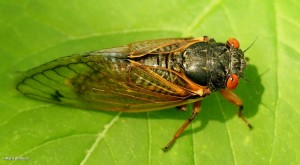 The immediate inspiration for resuming my blogs has been the emergence of the Great Southern Brood XIX (Magicicada spp.) of periodical cicadas — an animal species which humans only get to see every 13 years! This is the largest cicada brood in eastern North America, which is the only geographical area where they occur. I’ll share some of my current sightings and interesting tidbits about them and hope you enjoy this in a two-part blog.
The immediate inspiration for resuming my blogs has been the emergence of the Great Southern Brood XIX (Magicicada spp.) of periodical cicadas — an animal species which humans only get to see every 13 years! This is the largest cicada brood in eastern North America, which is the only geographical area where they occur. I’ll share some of my current sightings and interesting tidbits about them and hope you enjoy this in a two-part blog.
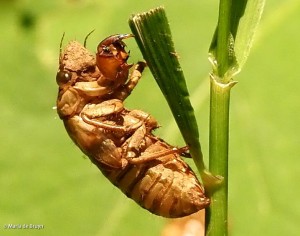 Periodical cicada eggs, laid above ground, hatch into nymphs which then go underground to pass through five juvenile stages before emerging 13 years later by the hundreds of thousands (even millions!). After emergence, they only live a few weeks, purely for the purpose of finding a mate and reproducing their species.
Periodical cicada eggs, laid above ground, hatch into nymphs which then go underground to pass through five juvenile stages before emerging 13 years later by the hundreds of thousands (even millions!). After emergence, they only live a few weeks, purely for the purpose of finding a mate and reproducing their species.
 One of the first noticeable things to alert humans to the coming “deluge” of cicadas, seen above, is the appearance of numerous holes in the earth as they tunnel out to the fresh air. This happens when the ground reaches a temperature of about 64°F/17.8°C.
One of the first noticeable things to alert humans to the coming “deluge” of cicadas, seen above, is the appearance of numerous holes in the earth as they tunnel out to the fresh air. This happens when the ground reaches a temperature of about 64°F/17.8°C.
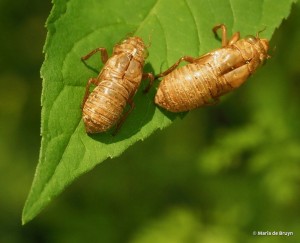 What emerges from the holes are brownish-tan nymphs, who crawl onto plant stems and tree trunks. Underground, they will have undergone four moulting periods as they grew during the past 13 years.
What emerges from the holes are brownish-tan nymphs, who crawl onto plant stems and tree trunks. Underground, they will have undergone four moulting periods as they grew during the past 13 years.
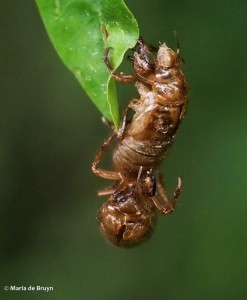 The vegetation becomes laden with these still immature insects almost everywhere you look.
The vegetation becomes laden with these still immature insects almost everywhere you look.
The adults emerge from their last exoskeleton through the back, which splits open. If you look carefully below, you can see one emerging on the right.
The newly emerged cicadas then undergo a quick maturation process within an hour or so.
They must unfurl and flex their new wings.
Their orange eyes take on a deep red — in my view mesmerizing — hue.
Seen head-on, their faces look to me as if there is a car grill in the middle.
The adults can’t fly right away after emergence but must make several attempts to get airborne.
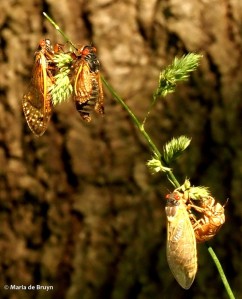 When the adults are ready to meet, the males begin making calls and songs, using a pair of ridged membranes on their abdomens. Some calls are a sign to gather; others are alarm calls made when the cicadas are handled.
When the adults are ready to meet, the males begin making calls and songs, using a pair of ridged membranes on their abdomens. Some calls are a sign to gather; others are alarm calls made when the cicadas are handled.
Their hollow abdomens are thought to act as a resonating chamber, increasing the volume of their already-loud sounds, When they gather in groups of hundreds and more, the volume can be astounding, reaching the level of a chainsaw or motorcycle.
In our area, numerous inquiries on neighborhood listservs commented on the growing and ongoing noise:
- Is there a sound like a siren going off that you can hear? It seems to be getting louder.
- Perhaps the machines grinding rocks to expand I 40 [highway].
- Alien invasion 😂
- The noise is continual with no change in pitch or volume. Sounds man made.
- This is some sort of machine or something running all day long.
- I was so intrigued as well that I called the energy company to investigate the cause of the intense noise!
- Miniature Flying UFOs made to look like Cicadas.
- This morning, I walked inside my house looking 👀 for the toilet that I thought was running.
 Some people made analogies for what they thought the cicada ‘songs’ were like:
Some people made analogies for what they thought the cicada ‘songs’ were like:
- To me it sounds like alien spaceships are landing – just like in a 1950’s creature feature.
- It sounds like the flying saucers in old 1950s movies.
- I think the 13-year bunch sound like the phasers on the original Star Trek show.
- To me they sound just like 18wheel rigs all revving up their engines.
- The sound to me is like “environmental tinnitus”. 🙂 [Response] Exactly, but it actually helps my tinnitus!
- Sounds like heavy traffic in another decade or two with everyone driving electric vehicles. [Response] My hybrid has that same sound (only quieter) to warn people/animals that I am backing up. When my car is operating under battery power, it’s silent, so manufacturers added that sound to warn people and wildlife away. You are so right. That may be the sound of the future. AAAAGH!
Others appreciated this natural phenomenon:
- Sounds great.
- I guess I am rare in thinking they are cool. It feels other worldly….
- And it’s all about SEX. Just think about all those teenage hot-rodders gunning their engines to attract attention. They’re all saying “Come and get me baby. I’m HOT.” After years underground, you would be too.
Finally, some listserv readers tired of all the comments after a while:
- Please stop asking about the sound Cicadas make! Please! And if someone answers, why do 50 people feel the need to respond? I feel that so much of the posts are so religious. Does anyone else feel this way?… I didn’t mean religious ! I meant repetitive!
- Cicadas are a plague sent from God signalling the End Of Time. The purple glow in the sky last night [Northern Lights] was the Rapture, and, since we’re still here … well, there’s that…
- If you don’t like it stop looking at the posts.
In the next blog, I’ll explain a bit more about the periodical cicadas’ vulnerabilities and life cycle. And hopefully you’ll enjoy seeing some more photos of these creatures who won’t see the light again until 2037!







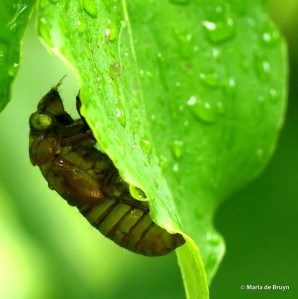
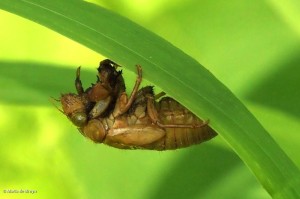
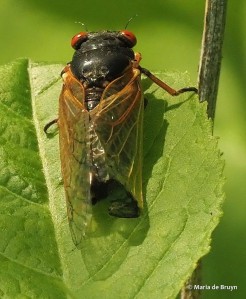
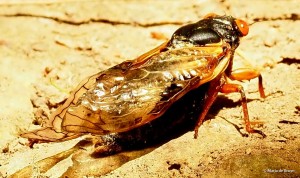

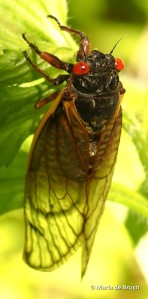
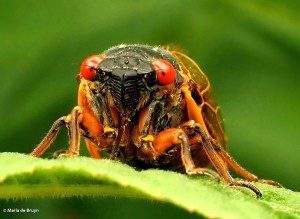
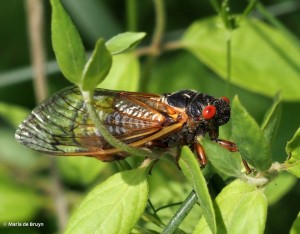

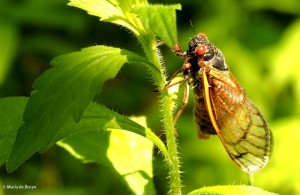


Fascinating. I hope you are better.
LikeLike
Thank you!!
LikeLike
Hi Maria! I’m glad you and your blog are back! I’m one of the people who like the cicadas and their song. There’s just so much life in the air! Not to mention the feast they are providing the birds.
LikeLiked by 1 person
I’m glad that you’re enjoying their presence, too, Lucretia! A few more weeks and we’ll be having quiet days!
LikeLike
This is the best explanation I’ve read so far of this amazing phenomena. I feel fortunate to be able to experience it and don’t mind the sound although I might not feel the same if it never ever stopped. I’m glad you are back and wish you well.
LikeLike
Hi Bree! Thanks for your kind words. Glad that it is not bothering you and on the contrary interesting for you – when I watched some of the cicadas on a walk today, it struck me yet again what a fascinating life cycle these insects evolved. In part 2, I talk about the threats they face and thought about that when I saw dead cicadas on paths when I took a walk today. As you say, it is an amazing phenomenon!!
LikeLike
Pingback: My unexpected encounters with wildlife continued this past month - The Local Reporter